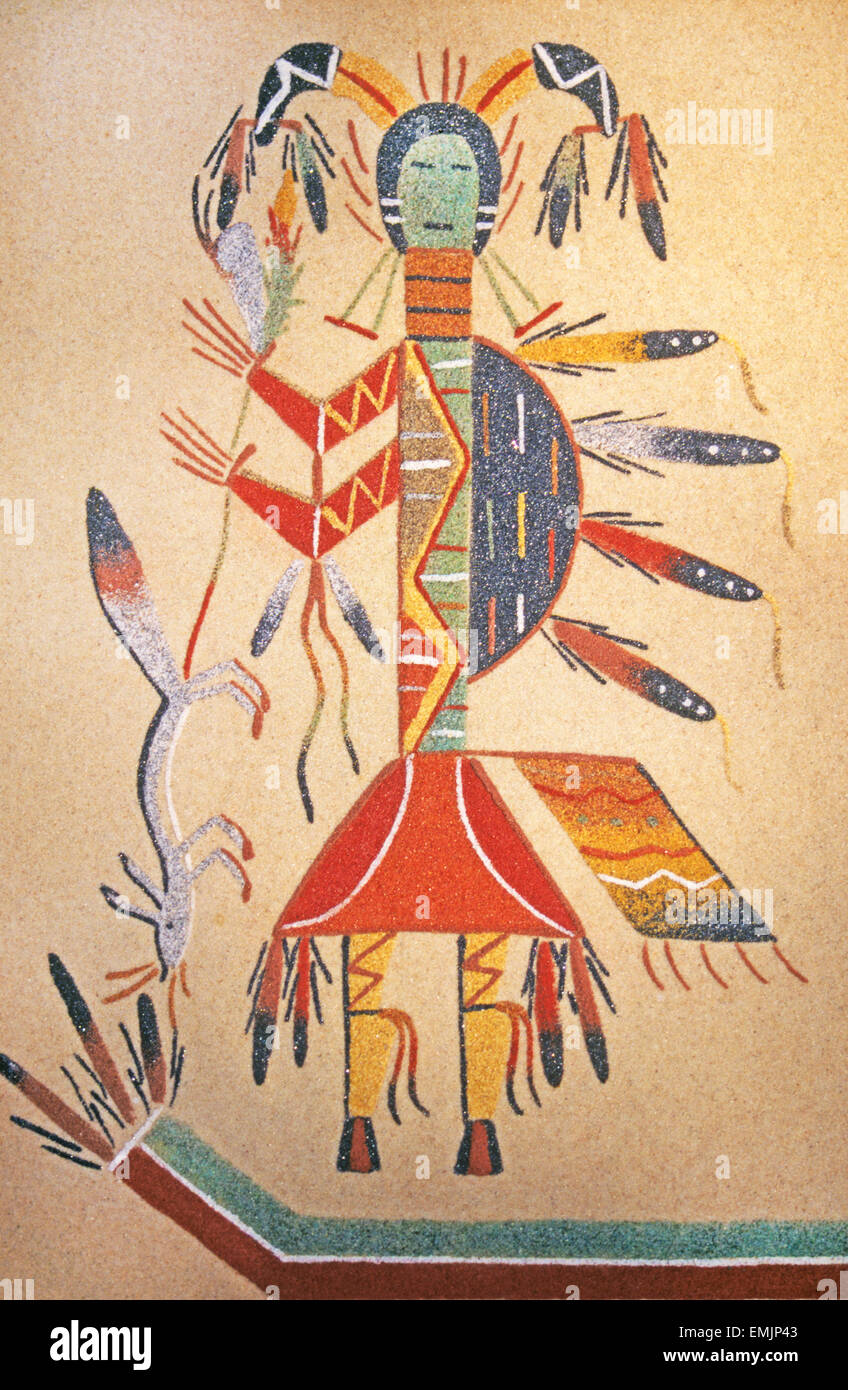
Echoes of the Sacred: Unveiling the Profound Meaning of Navajo Sand Paintings
In the vast, undulating landscapes of the American Southwest, where the red rock mesas meet the endless blue sky, lies a tradition as ancient and profound as the earth itself: the Navajo sand painting. To the casual observer, these intricate, vibrantly colored designs meticulously laid upon the ground might appear as exquisite works of art. Yet, to categorize them merely as such would be to fundamentally misunderstand their purpose, their power, and their sacred place within Diné (Navajo) culture. Far from being decorative objects, Navajo sand paintings are living prayers, transient altars, and powerful tools in the pursuit of Hózhó – the Navajo concept of universal balance, harmony, and beauty.
More Than Art: A Sacred Healing Tool

The very first and most crucial distinction to make is that authentic Navajo sand paintings are not art in the Western sense. They are not created for aesthetic pleasure, commercial gain, or permanent display. Their existence is ephemeral, their beauty fleeting, designed to be destroyed shortly after their sacred purpose is fulfilled. This transient nature is central to their power.
"They are not just pretty pictures," explains a representative from the Navajo Nation Museum. "They are part of a healing ceremony, a connection to the Holy People. Once the ceremony is done, their power is released, and they are returned to the earth."
Each sand painting is an integral component of a chantway (or hataał), a complex, multi-day healing ceremony conducted by a Hatałii (medicine man or chanter). These ceremonies are performed to restore an individual’s balance and harmony, which may have been disrupted by illness, misfortune, or psychological distress. The Diné believe that when a person becomes ill or experiences disharmony, it is because they have fallen out of sync with the natural order of the universe, or have violated a sacred taboo. The sand painting serves as a visual prayer, a cosmic map, and a direct conduit to the spiritual realm, designed to bring the patient back into alignment.
Hózhó: The Guiding Principle
At the heart of Navajo philosophy and the meaning of sand paintings is the concept of Hózhó. Often translated as "beauty," "harmony," or "balance," Hózhó is a far more expansive and profound idea. It encompasses the ideal state of the universe, the interconnectedness of all things, and the desired state of human existence. It is about living in right relationship with oneself, one’s community, the natural world, and the spiritual realm. When one is in Hózhó, they are walking in beauty, their life is blessed, and they are in tune with the cosmic order.
Illness, then, is Hóchxó, the opposite of Hózhó – a state of ugliness, disorder, and imbalance. The purpose of the chantway, and specifically the sand painting within it, is to transform Hóchxó back into Hózhó.
"The sand painting is a blueprint for restoring balance," says renowned Diné scholar and author, Dr. Robert S. McPherson. "It embodies the power of the universe, the Holy People, and the ancestral narratives that guide the Diné way of life. The patient enters this sacred space, and through ritual, song, and touch, absorbs that balance."
The Creation: A Meticulous Act of Prayer

The creation of a sand painting is a meticulously precise and highly spiritual endeavor, typically undertaken in the enclosed space of a hogan (the traditional Navajo dwelling), away from external disturbances. The Hatałii, often assisted by apprentices, lays down a canvas of sand, usually from a stream bed or a clean patch of ground, smoothing it out to create a perfect, level surface.
The "paints" are natural materials, each carefully gathered and processed: crushed minerals, sandstone, charcoal, corn pollen, and other plant materials, all ground into fine powders of various colors – white, blue, yellow, and black being dominant, representing the four sacred directions and the fundamental elements of the universe. The colors themselves carry deep symbolic meaning: white for dawn and the east, blue for sky and the south, yellow for twilight and the west, and black for night and the north.
With incredible skill and precision, the Hatałii allows the colored sands to trickle through his fingers, forming intricate designs directly onto the ground. There are no sketches, no templates; the designs are held entirely within the Hatałii‘s memory, passed down through generations of oral tradition and rigorous training. Each design is specific to a particular chantway and story, often depicting figures of the Diyin Dine’e (Holy People), sacred animals, plants, celestial bodies, or mythological landscapes.
The process of creation itself is an act of prayer and meditation, requiring immense focus and spiritual concentration. It can take many hours, sometimes even a full day, to complete a single painting, depending on its complexity and the specific needs of the ceremony.
Iconography and Symbolism: A Cosmic Map
The figures and patterns within a sand painting are not arbitrary; they are deeply symbolic representations of the Navajo cosmology, mythology, and spiritual principles. Common motifs include:
- The Holy People (Diyin Dine’e): These are the deities and spiritual beings who taught the Diné how to live in harmony and who continue to influence their lives. Figures like Changing Woman, Monster Slayer, Born for Water, and the various Ye’ii (supernatural beings) are frequently depicted. Their specific arrangement and attributes tell a particular story from the Navajo creation myth or a specific legend relevant to the patient’s ailment.
- Sacred Directions: The paintings are almost always oriented to the cardinal directions, reflecting the Navajo understanding of the cosmos. Often, guardian figures are placed at the four directions, protecting the sacred space.
- Rainbow Guardians: Rainbow figures often border the paintings, providing protection and symbolizing the connection between the earthly and spiritual realms.
- Animals and Plants: Bears, snakes, corn, squash, and other natural elements are frequently present, each carrying specific symbolic meanings related to healing, strength, sustenance, or transformation.
- Lightning, Stars, Sun, Moon: Celestial elements represent cosmic power, knowledge, and the cycles of life.
Every line, every color, every figure contributes to a complex narrative that is understood by the Hatałii and is meant to resonate with the patient on a deep, subconscious level. The painting becomes a microcosm of the universe, a sacred space where the patient can connect directly with the forces of balance and healing.
The Ritual of Healing and Absorption
Once the sand painting is complete, the heart of the ceremony begins. The patient is guided to sit upon the painting, usually in the center, or to have specific parts of their body touch corresponding parts of the sacred figures. The Hatałii then performs chants, prayers, and rituals, transferring the power and harmony of the painting into the patient.
The belief is that the illness or imbalance is drawn out of the patient and absorbed by the sacred images, while the sacred power and harmony of the Holy People and the universe are simultaneously transferred into the patient. It is a process of spiritual absorption and purification, a profound communion between the individual and the cosmic order. The patient literally becomes one with the sacred narrative depicted on the ground, allowing its healing energies to flow through them.
The Ephemeral Nature: Returning to the Earth
Perhaps the most striking aspect of Navajo sand paintings is their deliberate destruction. As soon as the healing ceremony is concluded, often within hours of its creation, the painting is systematically dismantled. The sands are swept up, usually starting from the center and moving outwards, and then carefully carried outside the hogan and returned to the earth, often scattered to the east.
This act is not merely about tidying up; it is an essential part of the ritual. It prevents the sacred power from being misused or lingering in an inappropriate way. It reinforces the transient nature of life and the cyclical journey back to the earth. It ensures that the power of the painting is released back into the universe, rather than being contained or commodified. It also protects the sacred knowledge from being trivialized or exposed to those who do not understand its profound meaning.
Modern Challenges and Cultural Sensitivity
In the modern era, the traditional practice of sand painting faces new challenges. The commercialization of Native American art has led to the creation of permanent "sand paintings" on boards, designed for sale to tourists. While these can be beautiful and represent a form of artistic expression, it is crucial to understand that they are not the sacred, ephemeral creations used in healing ceremonies. Authentic ceremonial sand paintings are never sold, preserved, or displayed permanently. To do so would be considered a sacrilege, a violation of their spiritual integrity.
The Diné people have worked to educate the public about this distinction, seeking to preserve the sacredness of their traditions while also sharing aspects of their rich culture. The training of new Hatałii is also a critical concern, as the oral traditions and intricate knowledge required to perform these ceremonies are complex and demand lifelong dedication.
A Legacy of Harmony
Navajo sand paintings stand as a powerful testament to a worldview deeply rooted in harmony, balance, and interconnectedness. They are not merely visual representations but active participants in a profound healing process, embodying the essence of Hózhó. Through their creation and destruction, they remind us of the cyclical nature of life, the importance of spiritual alignment, and the enduring wisdom of a people who strive to walk in beauty, every step of the way. To truly understand a Navajo sand painting is to glimpse not just a picture, but a prayer, a universe, and a path to healing etched in the very dust of the earth.


